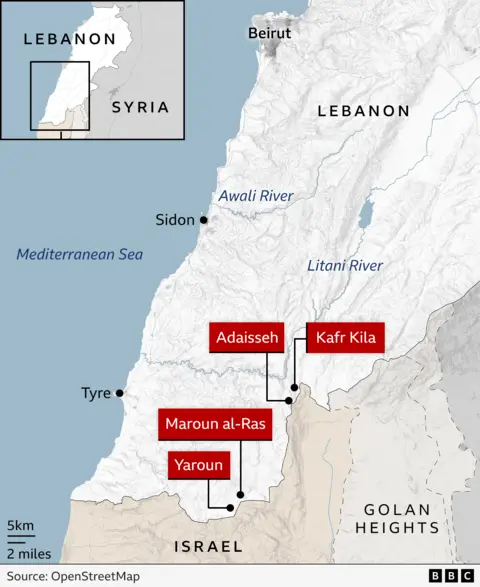Israel-Hezbollah conflict in maps: Where is fighting happening in Lebanon?
 BBC
BBCIsrael has invaded southern Lebanon in a dramatic escalation of its conflict with Hezbollah.
The Israeli ground operation began on 30 September, days after an air strike killed Hassan Nasrallah, the leader of the Iran-backed armed group.
Hezbollah has fired rockets into northern Israel as Lebanon has endured three weeks of aerial bombardment that Lebanese authorities say has killed more than 1,000 people and forced up to a million to flee their homes.
Israel has a decades-long history of conflict with Hezbollah but the war in Gaza has sparked a year of deadly cross-border fighting between them.
We will be continually updating maps in this page to help explain the conflict.
Map: Where is Lebanon?
Lebanon is a small country with a population of about 5.5 million people, which borders Syria to the north and east, Israel to the south, and the Mediterranean Sea to the west. It is about 170km (105 miles) away from Cyprus.

Where is the Israeli advance?
Israeli troops and tanks that had gathered close to the border crossed into Lebanon on 1 October.
The Israel Defense Forces (IDF) has said it is carrying out "limited, localised, and targeted ground raids" in southern Lebanon to dismantle what it calls Hezbollah's “terrorist infrastructure”.
 Reuters
ReutersIsraeli troops are fighting directly with Hezbollah fighters on the ground.
Several Israeli soldiers have been killed in mortar attacks and ambushes by Hezbollah during operations in southern Lebanon aimed at “eliminating terrorists”, according to the IDF.
Hezbollah said its fighters had clashed with Israeli forces in Adaisseh, Kafr Kila, Maroun al-Ras and Yaroun - all Lebanese villages close to the border with Israel.
A ground operation in southern Lebanon comes with many risks for Israeli forces. Unlike the flat coastal plains of Gaza, southern Lebanon has rolling hills and some mountainous terrain that makes it difficult for tanks to move easily without fear of being ambushed.
Hezbollah is also thought to have a network of tunnels in the region, with the group having been preparing for another full-scale conflict with Israel since the 34-day war in 2006.

As part of its invasion of southern Lebanon, the IDF has ordered people living in some villages to evacuate, telling those remaining to leave their homes and "immediately head to the north of the Awali River" – which meets the coast about 50km (30 miles) from the border with Israel.
At first the evacuation orders were concentrated in the south east of Lebanon, but in recent days more have been been issued for villages in the south west, perhaps indicating that Israeli operations are about to extend to that part of the border.
Lebanese civilians have also been warned by the IDF not to use vehicles to travel south across the Litani River, located about 30km (20 miles) north of the border.
About a million people lived in southern Lebanon before the conflict escalated almost a year ago.
Tens of thousands have been fleeing north since Israeli air strikes in the region intensified in late September. The main route for civilians trying to leave the south is the coastal road that runs the length of the country - but areas along that route have been hit by air strikes.

What have Israel’s air strikes targeted?
Israel’s invasion of southern Lebanon came after nearly two weeks of intense air strikes that Israel's military says target Hezbollah in the south of the country, the eastern Bekaa Valley and the southern suburbs of Beirut.
Israel says it is hitting Hezbollah sites, including weapons stores and ammunition dumps, but Lebanese officials say more than 100 women and children have been killed.
The majority of the rockets recently fired by Hezbollah have targeted northern areas of Israel. But some rockets have reached further south and damaged homes near the coastal city of Haifa.

There has been almost a year of cross-border hostilities between Israel's forces and Hezbollah, sparked by the war in Gaza.
Hezbollah has fired thousands of rockets at northern Israel during that time, forcing some Israelis living there to flee south, while the IDF has launched air strikes and artillery fire against Hezbollah positions in Lebanon.
As the chart below shows, the number of weekly Israeli attacks on Lebanon more than tripled in the week before the IDF launched its ground invasion. The number of Hezbollah attacks, while small in comparison, also increased in the same week.

Israel has intensified strikes on Beirut, the capital of Lebanon, in recent days.
The majority of the strikes have hit the southern suburbs of the city, densely populated areas that are home to thousands of civilians.
These areas, close to the international airport, also have a strong Hezbollah presence and a series of Israeli strikes on buildings there killed Hezbollah's leader Hassan Nasrallah on 27 September.
There have also been Israeli aerial attacks on locations closer to the centre of the city. A strike on an apartment block close to the Lebanese parliament building on 2 October killed several people, including rescue officers and paramedics, according to Beirut's civil defence.

The map below - using analysis of satellite data by Corey Scher of CUNY Graduate Center and Jamon Van Den Hoek of Oregon State University - shows which areas have sustained concentrated damage - including Dahieh in Beirut and areas along the border with Israel.

What will Israel do next?
Israel is now engaged in hostilities with armed forces and non-state armed groups in several countries in the Middle East, including Iran, Syria and Iran-backed groups operating in Lebanon, Gaza, Iraq, Syria and Yemen.
Iran's ballistic missile attack against Israel on Tuesday was the latest major escalation.
What happens next is unclear, but Israel has vowed to respond, with Prime Minister Benjamin Netanyahu describing the attack as "a big mistake" that Iran "will pay for".

